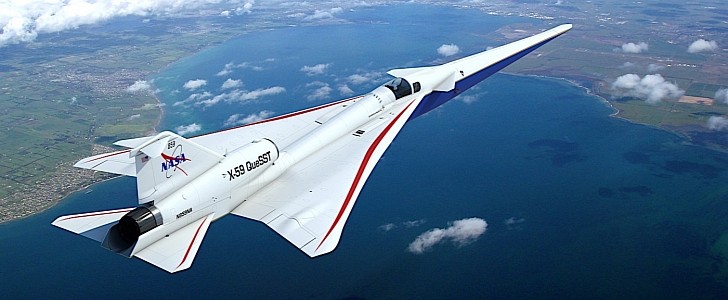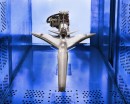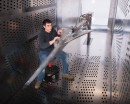Presently, overland supersonic commercial flights are banned because people are pretty annoyed (and some scared) of the sonic booms generated when aircraft break through the sound barrier. Needless to say, such a ban has pretty much dwarfed all efforts of speeding up air travel so far.
NASA hopes to change that with the X-59 research aircraft, also known as the QueSST X-Plane, short for Quiet SuperSonic Technology. By using their brains, engineers from the American space agency and its partners, especially the plane’s builder, Lockheed Martin Skunk Works, are planning to make supersonic travel overland possible without the loudness of a sonic boom and just a “gentle thump” instead.
Generally, sonic booms are created by a series of pressure waves in front and behind the aircraft. The ones in front move at the speed of sound and, as the airplane speeds up, are squashed together. They eventually merge into a single wave, creating a rise in pressure at the nose of the plane, followed by a return to normal pressure when the airplane passes through it.
That is when the sonic boom occurs, and just to give you an idea of what that means, imagine the sound of an F-16 breaking through the barrier may be more than 78 dB at over 8,000 meters altitude (26,200 feet). The civilian Concorde generated 90 dB.
NASA hopes to avoid this with the X-59 by separating shocks and expansions associated with supersonic flight. Sound levels should drop at 60 dB, which is the volume of an average conversation.
To see if the technology works, NASA has to test the airplane over populated areas, and last week announced it selected Massachusetts-based transportation planning company Harris Miller Miller & Hanson “to support a national campaign of community overflight tests.”
According to the data in the contract, the flights should take place over eight years, but no mention of when they’ll start or what the populated areas chosen for the experiments are was made.
NASA does say that following the flights, it will “ask residents to share their response to the sound the aircraft generates during supersonic flight.”
Generally, sonic booms are created by a series of pressure waves in front and behind the aircraft. The ones in front move at the speed of sound and, as the airplane speeds up, are squashed together. They eventually merge into a single wave, creating a rise in pressure at the nose of the plane, followed by a return to normal pressure when the airplane passes through it.
That is when the sonic boom occurs, and just to give you an idea of what that means, imagine the sound of an F-16 breaking through the barrier may be more than 78 dB at over 8,000 meters altitude (26,200 feet). The civilian Concorde generated 90 dB.
NASA hopes to avoid this with the X-59 by separating shocks and expansions associated with supersonic flight. Sound levels should drop at 60 dB, which is the volume of an average conversation.
To see if the technology works, NASA has to test the airplane over populated areas, and last week announced it selected Massachusetts-based transportation planning company Harris Miller Miller & Hanson “to support a national campaign of community overflight tests.”
According to the data in the contract, the flights should take place over eight years, but no mention of when they’ll start or what the populated areas chosen for the experiments are was made.
NASA does say that following the flights, it will “ask residents to share their response to the sound the aircraft generates during supersonic flight.”





